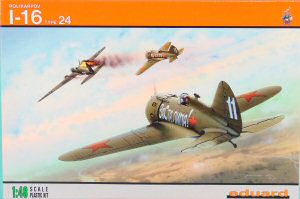
Eduard 1/48 Polikarpov I-16 Type 24 Kit First Look
By Michael Benolkin
| Date of Review | August 2006 | Manufacturer | Eduard |
|---|---|---|---|
| Subject | Polikarpov I-16 Type 24 | Scale | 1/48 |
| Kit Number | 8149 | Primary Media | Styrene/Photo-Etch |
| Pros | Very nicely detailed kit | Cons | See text |
| Skill Level | Intermediate | MSRP (USD) | $29.98 |
First Look
 |
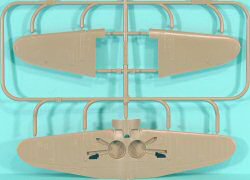 |
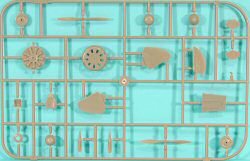 |
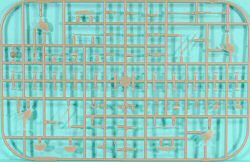 |
 |
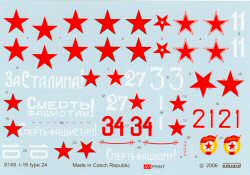 |
Polikarpov's design signature during the mid and late 1930s was stubby, barrel-shaped fighters. The primary machine during that era was the I-15 biplane. Like their barrel-shaped brothers on the other side of the world, the Grumman F3Fs, the I-15 was going to be transformed almost directly into a monoplane fighter, the I-16. In the transformation, the I-15's upper wing was deleted and the lower wing strengthened to carry the full load. With a wingspan one meter shorter than the I-15, the early I-16 was powered by the same 700hp M-25 radial engine as the late-model I-15. The I-16 also incorporated retractable landing gear which could be exchanged for retractable skis. Armament for the I-16 Type 104 was a pair of 7.62mm machine guns in the top of the nose and another pair in the wings just outside the propeller arc. The Type 17 retained the nose-mounted machine guns, while the wing-mounted guns were replaced with 20mm cannons.
The I-16 saw combat on two fronts in the late 1930s, first in the Spanish Civil War and later with the Chinese against Japan. In Spain, the early Bf 109s flown by the Nationalists were surprised by the agile I-16 and suffered losses to the 'Rata' (Rat) as they nicknamed it. The Japanese forces were also surprised by the agile I-16 until they finally discovered and exploited the I-16's weaknesses. By 1941, the Type 24 had become the primary version in service featuring a more powerful engine, standard radio equipment, and strengthened landing gear. This became the main production version of the I-16 and was later updated to the Type 29 briefly before being removed from service.
I rather like this unusual-looking aircraft as it resembles a 55 gallon drum with wings. I had enjoyed building the Hobbycraft 1/48 I-16 (later re-released by Academy) but I received several emails pointing out the inaccuracies in the kit. Perhaps, but since it was the only kit on the market, the discussion was moot. Until now.
Eduard has taken on the subject of the I-16 and it looks every bit as nice as the recent 1/32 Azur/Special Hobby I-16. At last, we have choices! In this release, Eduard has taken on the Type 24 variant. Molded in olive drab styrene, the kit is presented on four parts trees, plus a tiny clear stub containing the windscreen. The kit is rounded out with a set of color photo-etched parts.
Construction begins with the cockpit and Eduard has reconstructed all of the various cranks and levers in photo-etch, including a photo-etch throttle quadrant. There would be lots of cranks in the aircraft as nothing was mechanized in the aircraft - the landing gear had to be manually cranked up and down.
Look at the color photo-etch. The instrument faces and placards are beautiful. The pre-colored seatbelts and shoulder harness are also quite nice. Talk about a time saver with excellent results every time!
The engine cowling louvers are done in photo-etch and are positionable. Many kits mold these louvers closed to avoid having engine detail to contend with, but Eduard provides an engine face for behind the louvers. It was common to keep the louvers closed when warming up the engine or descending with the power at idle to keep the engine from thermal shock.
While the kit has a positionable rudder, the elevators are molded in the neutral position on the horizontal stabilizers and likewise for the ailerons on the wings. If you want to position them other than neutral, careful surgery will be required.
The landing gear detail is as nice as I've seen for the subject in any scale, and the instructions clearly show the proper placement of the retraction cable that extends from the wheel well to the axle.
The kit also provides an optional photo-etched cockpit entry door.
Markings are provided for six aircraft:
- I-16, White 11, 'Za Stalina' (For Stalin)/'Smert' Fashistam' (Death to Facists)
- I-16, White 10, 'Smert' Fashizmu' (Death to Fascism)
- I-16, Red 21, 4 GIAP, Baltic Fleet AF, 1942
- I-16, Red 34, 4 GIAP, Baltic Fleet AF, 1941
- I-16, White 27, 254 IAP, Leningrad, 1942
- I-16, White 3, 69 IAP, Odessa, 1941
This is a beautiful kit with excellent details throughout. This is certainly the nicest I-16 available in 1/48 scale.
My sincere thanks to Eduard for this review sample!







